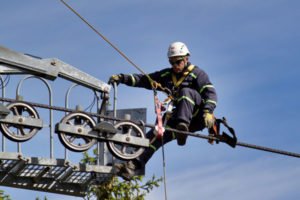The 2018 Lone Worker Safety Expo represented a shift in attitude toward mental health and wellbeing and a strong urge to re-define what the term lone working actually means. Mark Glover attended the event.

“Can you see why I struggle with this term lone worker?” said Nicole Vazquez, addressing delegates inside No 11 Cavendish Square, a grade 2 listed Georgian townhouse and venue for the conference.
Event organiser Nicole had just canvassed the floor asking delegates how their job role incorporates lone working: sectors including security, transport and retail were put forward. “It [lone working] can mean so many different things to so many different people,” Nicole responded. “But we have to somehow bring everyone together on all of this.”
Taking place in central London on October 2, the conference had undergone something of a re-brand. The show’s content looked to represent the fluid nature of lone working and to question the nature of the risks to employees. Content straddled legislation, regulation and technology but also ventured into new territory including mental health and wellbeing.
“Over the last couple of years there has been an advancement in the recognition that isolation can have on stress,” Nicole continued in her introduction to the day, acknowledging that the traditional idea of risk has now changed.
PUWER and COSHH
Still though, legislation and regulation underpins health and safety and following a welcoming address by Louise Ward, Health, Safety and Environment Director at Siemens, speakers from The Health and Safety Executive (HSE) and law firm Pinsent Masons gave delegates insight into what to look out for in that regard.
“There is no lone worker act or lone worker regulation said Sean Elson, Partner at Pinsent Masons, “Most of the issues that I see around lone working are seen through the prism of the general duties of the Health and Safety at Work Act, through risk-assessment, arrangements under the Management Regulations, PUWER and COSHH.”
And while the law, according to Elson “remains stable”, what is expected as ‘reasonably practicable’ is changing. “It does not stay the same. It is constantly moving,” he said. “What is it we have to do to satisfy our duties.” Referencing PPE: “It is changing at a rapid rate, even though the under lying legal duties, you could say, haven’t changed in years.”
The HSE was represented by Barbara Hockey, Head of the regulator’s Vulnerable Worker Team, an area that encompasses lone workers and in recent years has seen a shift in mental health, stress and wellbeing factors. The HSE’s management standards, Hockey said, are useful to apply when dealing with employers who have work related stress issues. “They apply a systemic approach,” she said, “so it can really help work through the issue.”
Additional guidance

Chris Shaw, Head of Health and Safety at North East London NHS Foundation Trust, shared with delegates the NHS’s mantra towards health and safety and lone working. “If you don’t look after your staff, then how can you look after your patients?” he said.
Shaw’s trust is a community and mental health one, and its many staff are seen as lone workers who often find themselves in vulnerable positions and Shaw explained the challenges involved in managing such a workforce. “The NHS across the UK, employs approximately two million people; it’s a business in itself,” he said. “across all sorts of roles: engineers and construction and they all lone work.”
Previous speakers Louise Ward and Sean Elson who were joined by Heather Beach from the Healthy Work Company, Adi Scott from Worthwhile Training, IOSH’s Duncan Spencer, BSIA Lone Worker Section Vice-Chairman Craig Swallow and Matthew Trigg from Human Applications for a lively panel debate on the morning’s content.
The panel and the floor came back to the definition of the term lone working and what it means in 2018 and beyond. “Additional guidance would be useful for the duty holders,” said Sean Elson, with a nod towards the HSE.
Stress
Post-lunch workshops covering managing violence and aggression, risk assessing and duty of care and helping employees stay safe while travelling abroad were all enthusiastically attended, including Heather Beach’s session on managing the mental health and wellbeing of lone workers. “A lack of human connection is a stress factor for lone workers,” she said before saying that “depression will be the leading cause of disability by 2020, according to the World Health Organization.”
It’s a startling statistic and one that took some delegates by surprise. The impact of stress on lone workers was one of the key takeaways from the day, as was the notion that some delegates didn’t even realise they had lone workers in their ranks at all.
Speaking to event organiser Nicole after the event she told me of one conversation she had with a delegate. “I came thinking I had six lone workers, but after today, I realised I had 54,” they told.
Nicole continued: “If today we have expanded the definition of lone working and highlighted to organisations how it can have a real impact on their employees’ safety, security and wellbeing, we will have achieved what we set out to do this year. Next year we aim to provide even more advice about how you manage the risks”.
What makes us susceptible to burnout?
In this episode of the Safety & Health Podcast, ‘Burnout, stress and being human’, Heather Beach is joined by Stacy Thomson to discuss burnout, perfectionism and how to deal with burnout as an individual, as management and as an organisation.
We provide an insight on how to tackle burnout and why mental health is such a taboo subject, particularly in the workplace.



